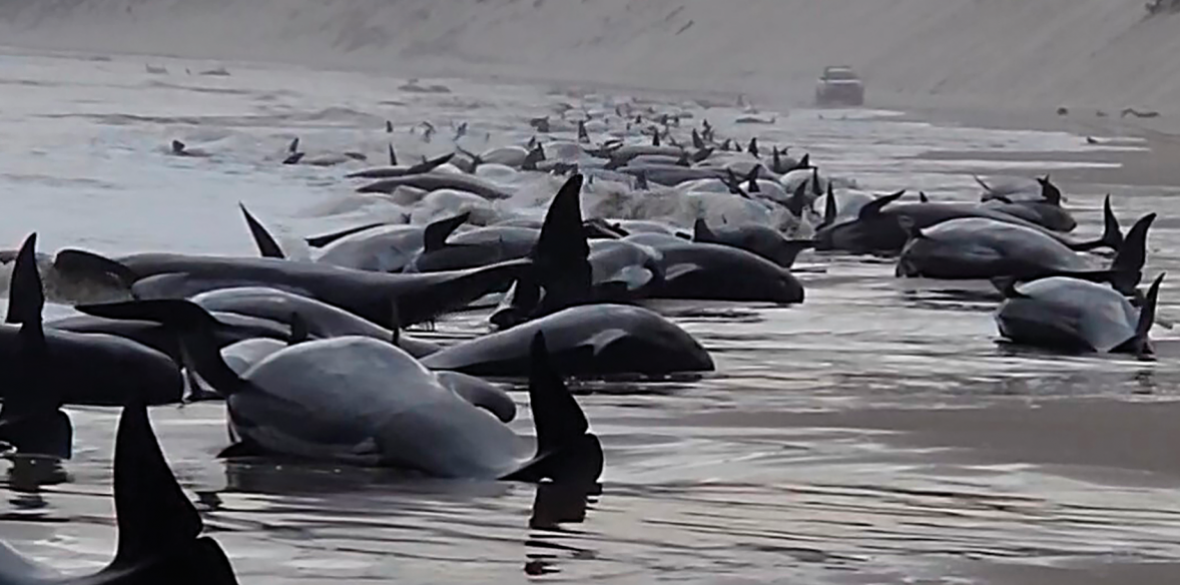This is the last article you can read this month
You can read more article this month
You can read more articles this month
Sorry your limit is up for this month
Reset on:
Please help support the Morning Star by subscribing here
EARLIER this week around 200 pilot whales died and just 35 are fighting for their lives following a mass stranding on an Australian beach in Tasmania.
The pilot whales were found yesterday stranded on an exposed beach along the coast of Australia’s biggest island — Tasmania.
Amazingly in 2020 an even larger pilot whale pod beached themselves on exactly the same spot. Few survived that mass beaching either.
The stranding occurred on Ocean Beach, west of Strahan, Tasmania. Some whales were also stranded on a sand flat inside Macquarie Harbour, south of the town.
Yesterday morning, authorities said only 35 of the 230 whales on Ocean Beach had survived. But the incident controller, Brendon Clark, said on Thursday afternoon that 32 of those 35 animals had been rescued.
“We still have three alive on the northern end beach, but because of access restrictions, predominantly tidal influences, we just haven’t been able to access those three animals safely today, but they’ll be our priority in the morning,” Clark said.
The exposed conditions on Ocean Beach contributed to the high death rate and for safety reasons local authorities were limiting volunteer involvement only to those with previous whale or marine wildlife training or experience.
In 2020, 470 long-finned pilot whales were found beached on sandbars and trapped inside the heads of Macquarie Harbour. This was Australia’s biggest-ever pilot whale stranding.
Authorities have asked vessel operators within Macquarie harbour to monitor for potential stranding at other sites. Some rescued or refloated animals may rebeach themselves. This is far too often the sad result of whale rescues.
The mass stranding is the second whale disaster to occur in three days in Tasmania. Earlier more than a dozen sperm whales, mostly young males and believed to be part of a bachelor pod, were found dead on another beach.
Both sperm and pilot whales were believed to be in the area because of the plentiful supplies of giant squid — key food for both whales — that had appeared along the continental shelf.
Rescuers were focused on avoiding rescued and refloated whales rebeaching themselves and local boaters have been asked to keep clear.
Local residents and whale enthusiasts have covered the huge beached beasts still on the sands with blankets and duvets made soaking wet with seawater in an effort to keep the animals alive. It is by no means always a successful technique.
Cases of whale stranding have baffled marine scientists for decades. Tasmania’s largest stranding was in 2020 when more than 450 pilot whales were found.
I have reported many incidents of pilot whale beaching, including many around the coasts of the British Isles as well as many other examples, large and small from all across the globe.
There have been many expert and non-expert theories on why these huge pods of pilot whales — and indeed other species — beach themselves.
Whales may beach themselves because they were sick, dying, giving birth or disoriented.
With pilot whales it may be that the leader and navigator of the pod may have become too sick to successfully and safely lead his pod from the beach and to safer waters.
Natural causes such as earthquakes and storms could be a factor; human causes, including noise, may lead to a whale beaching itself.
Many whale experts put the increase in beaching down to climate change making sea temperatures warmer. That is one theory being put forward about the many Tasmanian beachings.
Pilot whales fall into two species, the long-finned and the short-finned. The two are not readily distinguishable at sea. In fact the only way to accurately distinguish between the species is by close inspection of the skulls at autopsy.
Neither pilot whale species is in fact a whale. They are both actually very large dolphins. Size and weight depend on the species. Long-finned pilot whales are generally larger than short-finned pilot whales.
Adults can reach a body length of approximately 21 feet (6.5m) with males being three feet (1m) longer than females. Their body mass reaches up to 3,000lb (1,300kg) in females and up to 5,100lb (2,300kg) in males.
Even most experts on whales have no idea why so many whales and particularly pilot whales commit suicide by beaching themselves in large pods.
We do know that female pilot whales are one of the few mammals besides humans who have a menopause. Could that be something to do with it?
Fortunately the two species of pilot whale are not too seriously threatened. There are at least a million of them worldwide.
The only main predator is man. They are still hunted and eaten by the Japanese and Faroes islanders. Some are kept in captivity encouraged to do demeaning jumps and tricks for holiday visitors.
The other main predator beside we humans is another big dolphin that calls itself a whale — the orca or killer whale. They attack pods of pilots and individual animals but the fights aren’t as predictable as you might expect and pilots often come off best.











